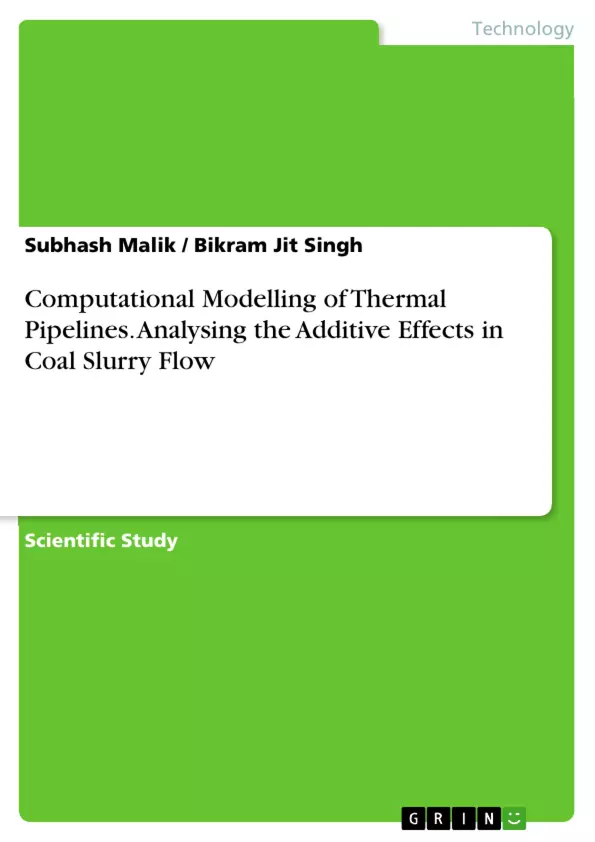This research work delves into the fascinating world of simulating and understanding the behavior of coal slurry in thermal pipelines. This groundbreaking book takes you on a journey through the intricate realm of computational modelling, uncovering the key factors and additive effects that influence the flow dynamics of coal slurry.
Through meticulous research and advanced simulations, this book provides a comprehensive exploration of the thermal aspects involved in coal slurry transportation. Gain invaluable insights into the role of additives and their impact on the overall performance of pipeline systems, as you examine the complex interactions between thermal factors, flow rates, and rheological properties.
With a focus on accuracy and precision, this book equips readers with the necessary tools to tackle challenges encountered in the field of thermal pipeline engineering. Explore various computational techniques, numerical methods, and advanced algorithms, empowering you to predict, analyze, and optimize the transport of coal slurry in thermal pipelines.
Whether you are a seasoned researcher, engineer, or a curious enthusiast, "Computational Modelling of Thermal Pipelines" offers a valuable resource for understanding the intricacies of slurry flow and the additive effects in coal transportation. Expand your knowledge, unravel the complexities, and unlock new possibilities in the realm of thermal pipeline systems.
Slurry pipelines are used to transport solid materials using water for short or long distance. These pipelines are used in many industrial application involving transportation of coal and disposal of slurry in thermal power plant. Transportation through slurry pipeline is a safe, pollution free and reliable method. In the present book, rheological properties of bottom and fly ash are studied to know the flow behavior of coal ash slurry. Numerical simulation is performed on the slurry flow through straight pipe and 90° pipe bend for the evaluation of pressure drop per 100 meter length. Modeling of Straight pipe and 90° pipe bend is generated in Gambit version 2.2.30 and Fluent version 6.2.16 is used for the numerical evaluation. Simulation has been performed on various concentrations (10%, 20%, 30%, 40% & 50%), with additive (40% & 50%) for bottom and fly ash slurries at various flow velocities (10, 20, 30, 32, 40, 41m/s).
Inhaltsverzeichnis (Table of Contents)
- INTRODUCTION
- COAL ASH
- Fly Ash
- Bottom Ash
- ASH HANDLING SYSTEM
- Bottom Ash Handling System
- Fly Ash Handling System
- SLURRY
- SLURRY TRANSPORTATION SYSTEM
- DIFFERENT TYPES OF LOSSES IN PIPELINE
- Losses in Straight Pipe
- Losses in Bend
- PIPE MATERIAL
- SURFACTANT
- Classification of Surfactant
- Triton X-100
- Benefits of Triton X-100
- Applications of Triton X-100
- COAL ASH
- LITERATURE REVIEW
- LITERATURE REVIEW
- GAPS IN LITERATURE
- PROBLEM FORMULATION AND OBJECTIVES
- PROBLEM FORMULATION
- OBJECTIVES
- RHEOLOGICAL CHARACTERISTIC OF BOTTOM AND FLY ASH
- PARTICLE SIZE DISTRIBUTION
- SETTLING PROPERTY
- pH VALUE
- SPECITIC GRAVITY
- RHEOMETER
- GRAPHICAL REPRESENTATION OF PROPERTIES OF BOTTOM AND FLY ASH
Zielsetzung und Themenschwerpunkte (Objectives and Key Themes)
This book delves into the computational modeling of thermal pipelines, focusing specifically on analyzing the additive effects in coal slurry flow. It examines the rheological properties of bottom and fly ash, exploring their impact on slurry flow behavior. The book further investigates the effectiveness of Triton X-100 as an additive to reduce viscosity and pressure drop within the pipeline.
- Computational modeling of thermal pipelines
- Additive effects in coal slurry flow
- Rheological properties of bottom and fly ash
- Pressure drop and viscosity reduction
- Optimization of thermal pipeline systems
Zusammenfassung der Kapitel (Chapter Summaries)
The book begins with an introduction to coal ash, its handling systems, and the concept of slurry. It explores the different types of losses in pipelines and provides an overview of pipe materials and surfactants, particularly Triton X-100. The second chapter presents a comprehensive literature review, identifying gaps in existing knowledge. The third chapter outlines the research problem and its objectives.
Chapter 4 delves into the rheological characteristics of bottom and fly ash, covering topics such as particle size distribution, settling properties, pH value, specific gravity, and the use of a rheometer. The chapter concludes with a graphical representation of the properties of bottom and fly ash.
Schlüsselwörter (Keywords)
Key terms and concepts explored in this work include thermal pipelines, coal slurry, bottom ash, fly ash, rheological properties, pressure drop, viscosity reduction, additives, Triton X-100, computational modeling, and optimization.
- Quote paper
- Subhash Malik (Author), Bikram Jit Singh (Author), 2023, Computational Modelling of Thermal Pipelines. Analysing the Additive Effects in Coal Slurry Flow, Munich, GRIN Verlag, https://www.grin.com/document/1372508



